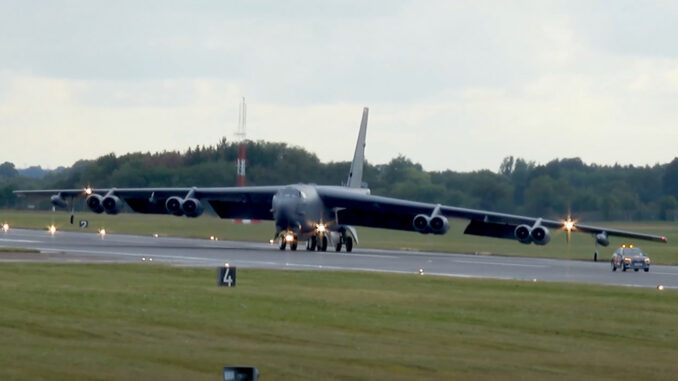Watch A B-52 Destroy Runway Lights While Taxiing Askew During ‘Crabwalk’ At RAF Fairford

After its display at RIAT (Royal International Air Tattoo), the B-52 Stratofortress bomber hit 18 runway lights with the outrigger wheel.
As usual, one of the highlights of RIAT 2023’s flying display this year was the U.S. Air Force B-52H Stratofortress bomber. The aircraft that took part in the flying display on Sunday Jul. 16, 2023, was airframe 61-0029/BD belonging to the 307th Bomb Wing/93rd Bomb Squadron, an Air Reserve Component of the United States Air Force, stationed at Barksdale Air Force Base, Louisiana.
Flying as SURGE 22, the strategic bomber took from runway 27, spent some time in a holding to the east of the airfield then carried out a flypast with tanker KC-135R QID 71 from Mildenhall in the lead and eventually returned for an overhead break for a visual landing. The most impressive part of the display (most probably cut short because of the weather that affected RIAT throughout the weekend) came after landing, as the BUFF (Big Ugly Fat Fellow) taxied down the runway using its peculiar steerable dual-bicycle landing gear to face the strong crosswinds at RAF Fairford.
Interestingly, during the “crabwalk”, the outrigger wheel of the Stratofortress aircraft hit some of the runway lights (18).
The video below, taken by our friend Misael Ocasio Hernandez, shows the full display of the B-52 including the taxi part. You can clearly see the lights “fall victim” to the the outrigger wheel, designed to keep the wing tanks from skidding on the runway.
Here’s a description of the characteristic swiveling landing gear of the B-52 from a previous article:
In fact, the U.S. Air Force iconic B-52 bomber was designed in such a way the landing gear can be set up to 20 degrees left to right of centerline for both takeoff and landing.
As explained by NASA (that has been a BUFF operator) on its website, “the landing gear of the B-52 is of the same bicycle arrangement as employed on the B-47 but has four two-wheel bogies instead of the two bogies used on the earlier aircraft. As compared with their location on the B-47, the outrigger wheels are positioned much nearer the wingtip on the B-52. An interesting feature of the B-52 landing gear greatly eases the problems posed by crosswind landings. Both the front and rear bogies can be set at angles of as much as 20° to either side of the straight-ahead position. In a crosswind landing, consequently, the aircraft can be headed directly into the wind while rolling down a runway not aligned with the wind.”
The reason for this peculiar feature is primarily due to the structure of the airframe that features a very long and relatively slender fuselage with a big tail and massive high wings that bear the weight of the aircraft. As a consequence of such design, the aircraft is slow to react to pilot inputs on the flight control surfaces, especially at low altitude and speed. Moreover, the wings are so large that the typical approach in crosswind [that is normally flown applying a Wind Correction Angle (WCA), hence “crabbing” the plane to align nose and tail with the wind direction to counter the drifting effect of side winds and “de-crab” once the main landing gear touches the ground (or shortly before)], is simply not possible.
